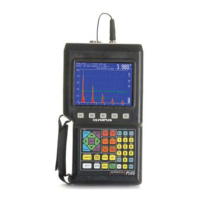72
EPOCH 4PLUS
- Soundpath leg of measurement
- Thickness/Soundpath values (Edge or Peak Depth mode), Current and
Maximum Amplitude data (Amplitude mode), or Time-of-Flight data
(Microsecond mode).
• Complete Waveform/Parameter Setup
- All data listed in the Thickness Reading section
- Waveform screen
- Peak Memory echo envelope or Peak Hold frozen waveform (if selected)
- Complete setup parameters
- Flag status (Freeze, Zoom, Peak Memory, etc.)
•Memo
- User defined memo typed via alphanumeric keypad
The EPOCH 4PLUS datalogger can store a maximum combination of 120,000 thickness
readings or 6,000 waveforms.
The EPOCH 4PLUS can save information in 500 separate files. The first nine files are
fixed files meaning that each file can only store one complete waveform/parameter setup
with an associated identifier (ID) code. This structure allows a quick recall for up to nine
calibration setups. This is useful when an operator changes transducers during an
inspection and needs to recall the associated stored calibration.
Files 10-500 are flexible files, which can store numerous thickness readings, waveforms,
and memos. Thickness, waveform data, and memos can all coexist in the same file.
Calibration waveform/parameter setups can also be stored in these files and recalled to the
live screen, although it requires an extra key press to do this (See Saving Waveforms and
Thickness Readings on page 5).
All the keys on the EPOCH 4PLUS alphanumeric keypad are in a common section on the
right side of the main keypad. Press [#] to allow access to the first function key presses (0,
1, 2, 3, 4, 5, 6, 7, 8, 9, ID.) Press [ALPHA] to allow access to the second function key
presses (Delete, the 26 letters of the Roman alphabet, and a variety of mathematical
symbols.)
8.2 Using the Memory Screen
To enter the Memory screen, press . The Memory screen is split into two windows.
• Lower window: displays a directory of files
• Upper window: displays the file contents
To toggle between the two windows, press [F1]. Other function key prompts appear when
applicable.
Press [F5] to exit and return to the live screen.

